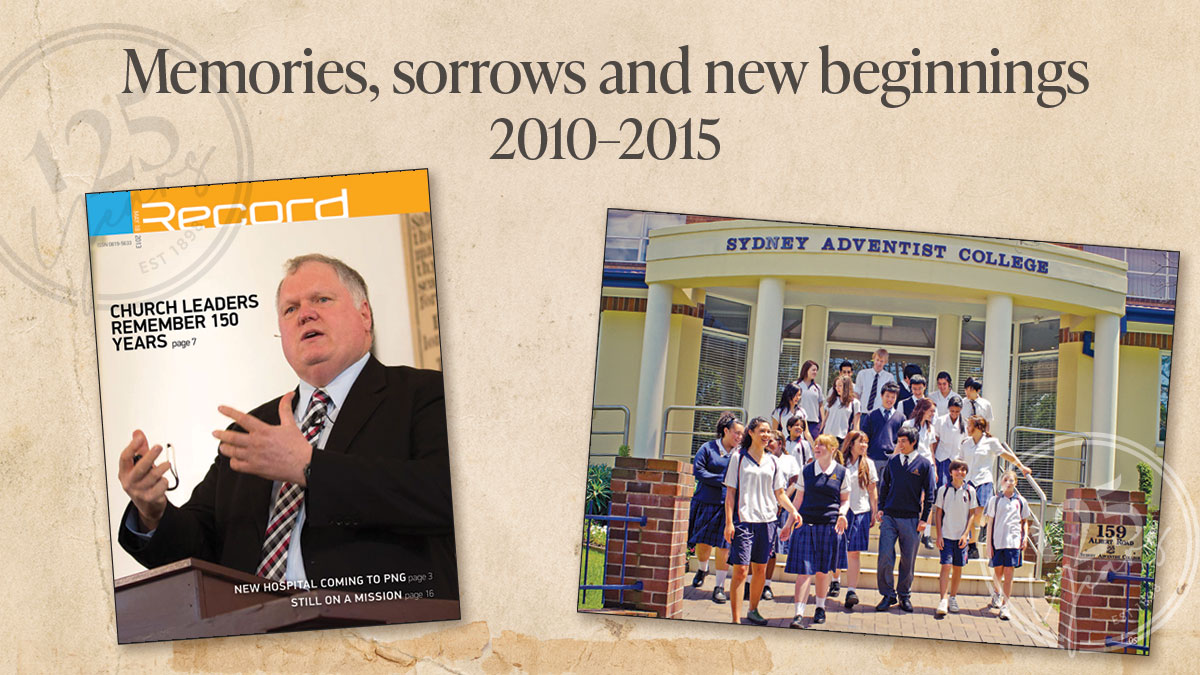The five years between 2010 and 2015 held many milestones for the Record, including the change of its name from Record to Adventist Record in 2014. The first milestone that marked this period was the transition from Warburton to Wahroonga. The editorial team had been working from Warburton in Victoria for years, but it was decided in 2009 that the Communication Department, the Adventist Media Centre and the Record editorial team would all be brought under one roof in Wahroonga. Designed to streamline communication, Warburton was nevertheless faced with the pain that accompanies such a move, including redundancies and job relocation issues.
Adventist Record also underwent stylistic changes during this period. In 2010, Record changed from black and white to full colour print, the size of each issue increased from 16 pages to 24 pages, and publications reduced from once a week to once a fortnight. Record also moved into the digital space, with the creation of a website, Facebook page and Twitter account. This all occurred under the editorial leadership of Pablo Lillo, who resigned in 2012 to pursue his calling in church ministry.
In 2012, James Standish took on the role of editor for the Record. Under the editorial leadership of James Standish, the Record focused on “honesty, spiritual integrity and relevance for its readers“.1
It is in this context which the following events unfolded and were covered by the Record.
Adventist Church turns 150!
On May 21, 1863, the Seventh-day Adventist Church became an official church organisation. 150 years later, this remarkable event was celebrated by the worldwide Adventist Church. World Church leaders met on April 12, 2013, to commemorate the Church’s 150th birthday at Battle Creek, the birthplace of the Adventist Church (Record, May 18, 2013). At its conception, the Adventist Church had 3500 members, but 150 years on there were more than 18 million Adventists worldwide. Today that number has exceeded 22 million.
Sydney Adventist College closure
At the end of 2012, Sydney Adventist College (Strathfield, NSW) closed its doors for the last time. Teachers and students alike said farewell to their much beloved school in a closing down ceremony on Sabbath, December 1 (Record, September 15, 2012).
It was with great reluctance that the Greater Sydney Conference decided to close Sydney Adventist College (SAC) after a significant and continuous decline in enrolments. At its peak in the 1980s, SAC had roughly 550 students enrolled each year, but by 2012 there were only 146 secondary students enrolled. This decision also came as a result of the significant costs involved in keeping the school operational, costing the Conference $A4.2 million in the last 10 years of its operation (Record, November 17, 2012).
During its 93 years of operation, SAC provided a rich environment for nurturing and educating young minds to prepare them for the future.
What’s the date today?
At midnight on Thursday, December 29, 2011, Samoa skipped forward a day to Saturday, December 31, deleting an entire day from their calendar. This was done to align Samoa with the calendar of Australia, New Zealand and Asia, as Samoa sits very close to the International Date Line.
The executive committee and administration of the then Samoas-Tokelau Mission spent a considerable amount of time planning for and deliberating on this matter, concluding that the Sabbath should be kept on the “seventh day“ rather than the day named “Saturday“ (Record, February 4, 2012). This reasoning was grounded in the biblical principle that the Sabbath is the seventh day of the week, and strengthened by the belief that man should not have the authority to change times and days (Record, February 4, 2012).
Now you’re speaking my language
At the end of 2010, Pacific Adventist University (PAU) in Port Moresby, Papua New Guinea, completed the world’s first audio Bible in Tok Pisin. These audio recordings of the Bible were placed on special MP3 players nicknamed “Godpods” to be distributed across Papua New Guinea in 2011. These Godpods were aimed specifically at illiterate people groups, which was around 50 per cent of the population of Papua New Guinea.
“When [the Bible] is spoken in a language you understand, it becomes a life-transforming power none can compare to” (Record, January 22, 2011).
A user-friendly translation of the Bible was also developed for Aboriginal and Torres Strait Islander peoples in 2011, being designed to inspire more Indigenous Australians to engage with God’s Word (Record, August 20, 2011). The Easy Reading Family Edition was developed by the national Aboriginal and Torres Strait Islander Ministries (ATSIM) team in partnership with the Bible Society of Australia.
Shake, rattle and roll
The year of 2011 was disastrous . . . literally! With earthquakes to shake New Zealand, civil war and drought to rattle countries in Africa, and floods to roll through vast regions of Queensland, the lives of millions around the world were devastated.
To start the year off, there was significant flooding in North New South Wales and Queensland. The flood waters completely covered houses and roads with mud and debris, with more than 500 people requiring emergency accommodation. Toowoomba was one of the worst flood-affected regions, with volunteers being overwhelmed by “caravans in trees, a skip bin on top of a two-storey home, the stench of rotting vegetation and mud.“ (Record, February 5, 2011). ADRA was quick to respond to the disaster, providing food, clothing and emergency accommodation for those impacted by the torrent.
On February 22 at 12:51pm, Christchurch experienced a 6.3-magnitude earthquake, killing 185 and injuring thousands. The cost of the damage was $NZ16 billion!2 Church communities across Christchurch dedicated their Sabbath following the earthquake to help those in need (Record, July 2, 2011).
In July, the “worst humanitarian disaster in the world“3 struck Somalia—a devastating famine. ADRA organised a special appeal to provide support for Somalian refugees surviving in Kenya (Record, November 5, 2011). Not only was Africa hit by drought, but Cote d’Ivoire erupted in a civil war following controversial elections in 2010, leading to 1 million people fleeing their homes, families and country, with ADRA working tirelessly to support many of these people.
Also of note:
- Currawah Adventist Aboriginal College officially opened on June 6, 2011.
- Adventist teen Chantel Amiss was awarded Young Citizen of the Year in 2010, for raising $A18,000 for the Cambodia Kids Foundation.
- InFocus Adventist News television program aired on the Australian Christian Channel in 2010 for the first time.
- Sanitarium Health Food Company closed its factory in South Australia on October 29, 2010.
- The Seventh-day Adventist Church in Vanuatu turned 100 on June 12, 2012.
1. Bruce Manners, “Adventist Record“, Encyclopedia of Seventh-day Adventists, January 29, 2020.
2. Eileen McSaveney, “Historic earthquakes—The 2011 Christchurch earthquake“, Te Ara, the Encyclopedia of New Zealand, <TeAra.govt.nz/en/historic-earthquakes/page-13> (accessed 30 October 2023).
3. “In Somalia, UN official urges massive response for world’s ‘worst humanitarian disaster’“, The United Nations, UN News, <news.un.org/en/story/2011/07/381262> (accessed 30 October 2023).






